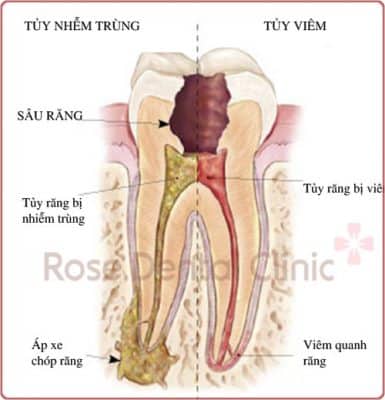What is root canal treatment? Problem, Process and Recovery
Root canal treatment is a dental procedure to treat infection at the centre of a tooth, it is also called endodontics. This procedure can also keep the tooth from future infection. The dentist will remove the tooth pulp inside the tooth root canal.
The structure of a tooth

A tooth is made up of two parts:
- The crown is the part of the tooth that is visible in the mouth.
- The root extends into the bone of the jaw, anchoring the tooth in position.
These are composed of the following structures:
- Enamel is the hard outer coating of a tooth.
- Dentine is a softer material that supports the enamel and forms most of the tooth.
- Cementum is a hard material that coats the root surface.
- Dental pulp is the soft tissue at the centre of the tooth.

The root canal system contains the dental pulp and extends from the crown of the tooth to the end of the root. A single tooth can have more than one root canal.
How dental pulp became infected?
The pulp is made up of soft tissue that includes nerves and blood vessels. If bacteria infect the pulp, it will begin to die. After this, the bacteria can increase in number. The bacteria and the substances they release will eventually pass out of the end of the root canal through the small hole where the blood vessels and nerves enter.
This process continues as there is nothing to stop more bacteria passing down the root canal, which causes the tissues around the end of the tooth to become red and swollen. This can cause your tooth to become painful and, in extreme circumstances, your face may become swollen.
What is a root canal treatment?
The root canal is a part of the tooth. It is an empty room inside the tooth carrying nerves, blood vessels, and other tissues. All of which are referred to as the tooth pulp. The tooth anatomy consists of a tooth crown above and a tooth root below the gum line. The tooth root helps keep the tooth bound in place with the jaw bone.
The tooth pulp provides nutrition for the tooth and moisture for both teeth and gums. The nerves in the tooth pulp help sense hot and cold temperatures as well as pain. Without the pulp nerves, the tooth normal functions are still not affected.
Root canal treatment is carried out to treat damaged teeth due to cavities or severe infection. During the procedure, the nerves are removed and the root canal is cleaned, then the tooth hole will be sealed. If you don’t receive root canal treatment in time, the tissue surrounding the tooth will get severely infected and may result in abscesses.
Why should you receive this treatment?
When the nerves and tooth pulp are damaged, bacteria will grow in the root canal and destroy the tooth structure. The tooth can be infected and tooth abscesses may form after that. An abscess is the formation of a sac of pus at the end of the tooth root occurring when the infection has spread all over the tooth. Besides tooth abscesses, an infected root canal can also cause:
- Swelling that can spread to other parts of the face such as the neck and head
- Loss of bones surrounding the tooth root
- Loss of nutrients to keep the tooth alive and healthy
For more information, read this article: When do you need a root canal treatment?
Root canal treatment procedure
A root canal treatment usually includes 3 main steps which will take you several days or more to complete, depending on your tooth condition.

1. Clean the root canal
Your dentist will administer local anesthesia around the affected tooth and drill a small hole on its surface. Next, they will use specialized tools to remove damaged or dead pulp tissues in order to clean the root canal completely.
2. Fill the entire root canal
Your dentist will clean and sterilize the empty space in the root canal using specialized tools. They will then use a dental material as an adhesive cement to fill the hole completely. After the treatment, the tooth is considered dead. You will feel nothing at the tooth whose pulp has been removed as the nerves and infection have been eliminated.
3. Attach a dental crown or perform dental filling
A tooth whose pulp has been taken out will be more “vulnerable” as it now receives nutrition from just the periodontal ligament. The tooth will also become more brittle with time, and hence, a crown or tooth surface filling is needed to give extra protection.
Avoid chewing or biting with the affected tooth until your tooth is crowned or filled completely. You can return to your normal diet when the tooth has been fully restored.
The duration of root canal treatment depends upon your oral condition and whether there are any incidents after the procedure. Your dentist will set appointments with you to complete your root canal treatment plan.
Read more: Is root canal treatment painful?
After the procedure
Your tooth may get more sensitive for a few days after treatment due to the inflammation of the natural tissue, especially when you have had an infection beforehand. This discomfort can be managed with non-prescription pain medications such as ibuprofen or naproxen.
Also, avoid chewing with the side of the treated tooth after a root canal to prevent infection from recurring and the tooth from breaking before it has fully recovered
To treat the infection in the root canal, the bacteria need to be removed. This can be done by:
- Removing the tooth (extraction)
- Attempting to save the tooth by removing the bacteria from the root canal system (root canal treatment)
In root canal treatment, once the bacteria are removed, the root canal is filled and the tooth is sealed with a filling or crown. In most cases, the inflamed tissue at the end of the tooth will heal naturally.
Root canal treatment should not be painful because a local anesthetic is normally given, it should be no more unpleasant than having a filling. The procedure is usually successful. In about 9 out of 10 cases, a tooth can survive for up to 10 years after root canal treatment.
Read more: Overview of root canal treatment procedure
What is the success rate of root canal treatment?
The success rate of this treatment is rather high, typically more than 95%. Many people who have undergone this treatment lead to a normal life without any problems. As the final step of the root canal treatment is attaching a dental crown or receiving restorative tooth filling, no one will ever recognize your tooth pulp has been removed.
Complications after the treatment
When the tooth pulp has been taken out, the root canal will be empty, which will make the tooth more prone to breaks. Attaching a dental crown to the affected tooth can give better protection. However, sometimes a crack is not detected during the procedure and the dentist will have to remove the tooth even though the procedure has been performed.
In some cases, the dentist may have trouble finding the root canal as it has become thin or calcified, which may cause a tooth hole. If the hole is not serious, the dentist can perform tooth filling to restore it. Otherwise, the tooth may need to be removed.
A tooth infection can recur due to improper tooth filling, poor oral hygiene, or filling materials breaking off over time. Sometimes, when there is more than one root canal in a tooth and the dentist has missed the sub-root canal, myelosuppression can occur. This sub-root canal may also have infected tissues, and hence, it needs cleaning and filling.
The upper teeth can be located too close to the sinus cavities and, sometimes, the tooth roots even “penetrate” into sinus cavities. Therefore, obstruction of sinus cavities can occur during root canal treatment due to inflammation or infection around the tooth root.
Discoloration is also possible after the treatment. If that is the case, the tooth will turn dark yellow, brown, or more gray than the adjacent teeth. If this discoloration affects the appearance of your teeth, especially when it comes to the front teeth, you can receive teeth whitening, dental veneers, or crowns to improve this problem.
To ensure your safety and minimize serious complications after root canal treatment, do your research and opt for trustworthy, high-quality dental clinics with a team of experienced dentists.
Healthy, radiant teeth are what make a beautiful smile. So how to best take care of your oral health? It’s recommended that you and your family members should visit your dentist once every 6 months to get timely diagnosis and treatment for any oral problems.
Aftercare
It is important to look after your teeth when recovering from root canal treatment. You should also avoid biting on hard foods until all treatment is complete.
Most people can help prevent the need for further root canal treatment by:
- Maintaining good oral hygiene
- Being careful to avoid too much sugary food in your diet
- Quitting smoking, if you smoke
Services
Working Time
- Monday - Friday: 08:00 - 19:00
- Saturday: 08:00 - 18:00
- Sunday closed
Contact Info
- Hotline 1: (+84) 908 321 455
- Hotline 2: (+84) 931 857 885
- Mobile: (+84) 8 3925 8778
- Phone: (+84)2 838 258 778
- info@dentalrose.net
- rosedentalclinicvn@gmail.com
 English
English  Tiếng Việt
Tiếng Việt

